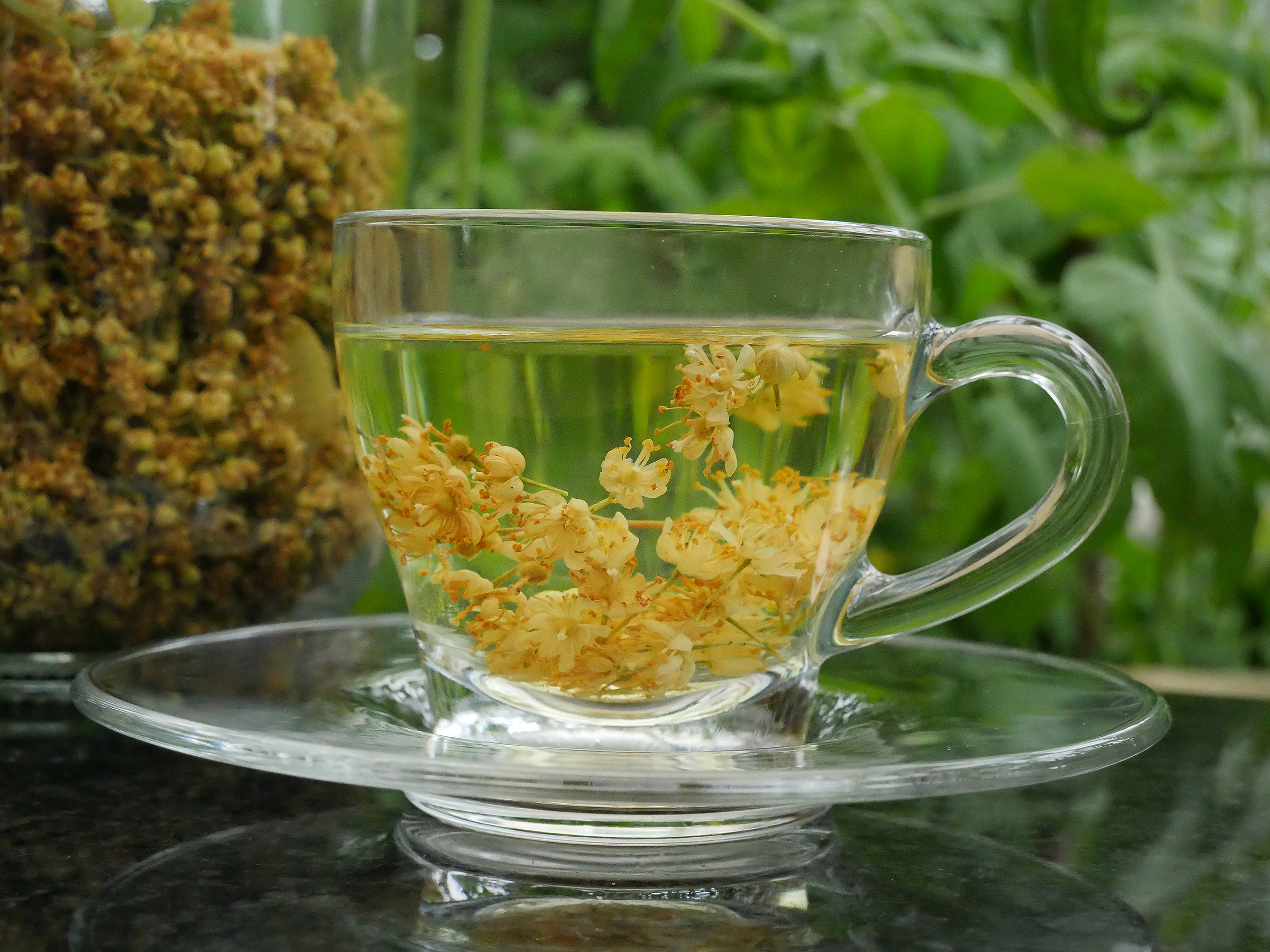Linden tea is a mild, hydrating infusion. Drinking linden tea may help you relax, improve sleep, and calm your digestive system.
For centuries, linden tea has been appreciated for its calming, sedative qualities (1).

It’s made from trees in the Tilia genus, which commonly grow across temperate zones in North America, Europe, and Asia. Tilia cordata, or small-leaved lime, is often considered the most active species within the genus (1).
Traditional medicine in many cultures has used linden preparations to support lower blood pressure, ease anxiety, and settle the stomach.
This herbal brew is prepared by boiling and steeping the flowers, leaves, and sometimes the bark. Each part of the plant has a history of distinct therapeutic uses (1).
Below are eight noteworthy benefits associated with linden tea.
1. May encourage relaxation
Sitting with a warm cup of tea is calming by itself.
Still, linden tea may offer more than the usual comfort of a hot beverage.
The steeped, fragrant blossoms have a long folk-medicine tradition of easing nervousness and promoting calm, and some research provides supporting evidence (2).
An animal study reported that extracts from the buds of Tilia tomentosa displayed pronounced sedative activity (2).
Investigators suggested the extract acted similarly to gamma-aminobutyric acid (GABA), a neurotransmitter that reduces neuronal excitability (2).
Therefore, linden tea might foster relaxation by mimicking GABA activity. However, further studies are necessary to clarify the exact mechanisms (2).
Summary Linden tea could help you relax by lessening nervous excitability. Human evidence is limited.
2. May help combat inflammation
Chronic inflammation contributes to many diseases, including type 2 diabetes and certain cancers (3).
Antioxidants help counter inflammation and may reduce disease risk. Tilia flowers contain flavonoids, while linden buds specifically contain tiliroside, quercetin, and kaempferol (1, 3, 4, 5).
Tiliroside is a strong antioxidant that neutralizes free radicals, which can otherwise cause oxidative damage and inflammation (1, 6, 7).
Kaempferol also appears to have anti-inflammatory actions and some studies suggest possible anti-cancer activity (5).
Because levels of these antioxidants vary by brand and how the blend is made, more research is required to determine how much linden tea would be needed to meaningfully reduce inflammation.
Summary Linden tea contains antioxidants such as tiliroside and kaempferol that may reduce inflammation. Chronic inflammation is linked to diseases like diabetes and cancer.
3. May ease mild pain
Chronic pain affects millions globally. In 2016, about 20% of U.S. adults reported persistent pain. Some antioxidants present in linden tea might help mitigate pain (8).
In one animal experiment, administering 45.5 mg of tiliroside per pound (100 mg per kg) to mice with inflamed paws reduced swelling and pain by around 27% and 31%, respectively (6).
An eight-week trial in 50 women with rheumatoid arthritis — a condition marked by joint pain and stiffness — found that 500 mg of quercetin daily significantly improved pain and inflammation markers (9, 10, 11).
However, 500 mg of quercetin is a large dose. U.S. adults typically consume about 10 mg per day on average, though intakes vary and 80 mg per day is considered high (10, 11).
The quercetin and other flavonoid content in linden tea depends heavily on the product and the ratio of buds, leaves, and bark, so the amount in any cup is uncertain.
Consequently, more research is needed to know how much linden tea would be required to meaningfully reduce pain and whether such amounts are safe.
Summary Tiliroside and quercetin in linden tea could help lower pain. More studies are needed to determine the effective and safe quantities of tea for pain relief.
4. May act as a diuretic
The inner bark of Tilia has traditionally been associated with diuretic and diaphoretic actions. Diuretics increase urine output, while diaphoretics promote sweating to help reduce fever (12, 13).
Linden tea has been used to encourage sweating and loosen productive coughs during mild illnesses such as colds (1).
In Germany, 1–2 cups (235–470 ml) of linden tea at bedtime are approved as a sweating-promoting infusion for adults and children over 12 (1).
These effects might stem from compounds such as quercetin, kaempferol, and p-coumaric acid, though direct scientific proof connecting linden’s chemistry to diuresis is limited (1).
Most evidence for this use is anecdotal and dates back to medieval times, indicating a need for more formal study (1).
Summary Linden tea has a traditional reputation for promoting sweating and acting as a mild diuretic, but stronger scientific evidence is needed.
5. Associated with lower blood pressure
Compounds found in linden tea — including tiliroside, rutoside, and chlorogenic acid — may have blood-pressure-lowering effects (1, 6, 14, 15).
One animal study showed tiliroside influenced cardiac calcium channels; calcium is important for heart muscle contractions (6, 14, 16).
Mice receiving doses of 0.45, 2.3, and 4.5 mg per pound (1, 5, and 10 mg per kg) showed reductions in systolic blood pressure (6, 14, 16).
These findings might explain the traditional use of linden for blood-pressure support.
Nonetheless, the mechanism is not fully clarified and more research is warranted. Linden tea should never be used as a substitute for prescribed heart medications.
Summary Traditional use suggests linden tea may lower blood pressure, but the precise mechanism is unclear and requires further study.
6. May improve sleep
Both sleep quality and duration are crucial for overall health.
Linden tea is commonly used to promote sleep in folk practice. Its plant constituents have sedative qualities that could encourage relaxation and drowsiness (1, 12, 17).
An animal study using extracts from Mexican Tilia species produced sedation, which researchers attributed to central nervous system depression (2, 18).
More human studies are needed to better understand how linden tea may influence sleep.
Summary Linden tea is traditionally used to support sleep, though scientific evidence remains limited and largely anecdotal.
7. May calm your digestive tract
Like other warm teas, linden provides soothing heat and hydration. Both help the digestive system, as fluids assist the movement of food through the intestines. Folk remedies often recommend linden for stomach upset.
In one small study of children with antibiotic-resistant diarrhea, tiliroside displayed notable antibacterial effects. While this compound was obtained from a different plant source in that study, tiliroside is also present in linden (19).
Still, direct evidence that linden tea constituents soothe irritated digestive tissue is lacking.
Summary Linden tea might ease digestive discomfort. Tiliroside has shown antibacterial activity against certain diarrheal infections, but more targeted research on linden tea is necessary.
8. Simple to incorporate into your routine
Including linden tea in your diet is straightforward. Since it can encourage relaxation and sleep, a cup before bed may be helpful. Enjoy it plain or with a slice of lemon and a spoonful of honey.

You can also steep several bags overnight in room-temperature water to make a refreshing iced tea for summer.
When possible, brew loose-leaf linden rather than using tea bags. Steeping loose leaves often preserves more antioxidants (20).
Summary Brewing a warm cup of linden tea is an easy dietary addition. To maximize antioxidant content, steep loose leaves without filter bags.
The downsides
The European Medicines Agency considers moderate intake — about 2–4 grams of the tea blend per day — to be safe, and recommends against excessive consumption (1).
A standard 8-ounce (235-ml) mug of linden tea contains roughly 1.5 grams of loose tea, though extraction varies. Limiting intake to no more than three cups daily is advisable (1).
Although generally regarded as safe, avoid linden tea if you have an allergy to the plant or its pollen.
Safety for children, pregnant, and nursing women
There’s insufficient evidence about the safety of linden tea during pregnancy and lactation, so it’s best avoided in these situations.
Its effects in children haven’t been well studied either, so routine use in kids is not recommended.
Possible medication interactions
People taking lithium-containing medications should not consume linden tea, as it can alter lithium excretion and affect dosing, with potentially serious consequences.
Because linden may increase fluid excretion, avoid combining it with other diuretics to lower the risk of dehydration.
Summary While linden tea offers many potential benefits, long-term or heavy use may cause problems. It should be avoided by children, people with heart conditions, those on certain medications, and by pregnant or breastfeeding women.
The bottom line
Linden tea comes from Tilia trees and has a long history in traditional medicine.
Although its blossoms are most prized, the leaves and bark can also be brewed into a fragrant, pleasant beverage.
Drinking linden tea may help you relax, reduce inflammation, ease pain, and calm the digestive tract.
However, people taking some medications, those with certain heart conditions, and pregnant or breastfeeding individuals should avoid it. Consume this tea in moderation rather than daily.
It’s easy to add linden tea to your diet; for the most benefit, brew it loose-leaf. If you enjoy herbal teas, you might also like to explore rosehip tea as another soothing option.
If linden tea isn’t available locally, you can find tea bags and loose leaves online.


















Leave a Reply
You must be logged in to post a comment.